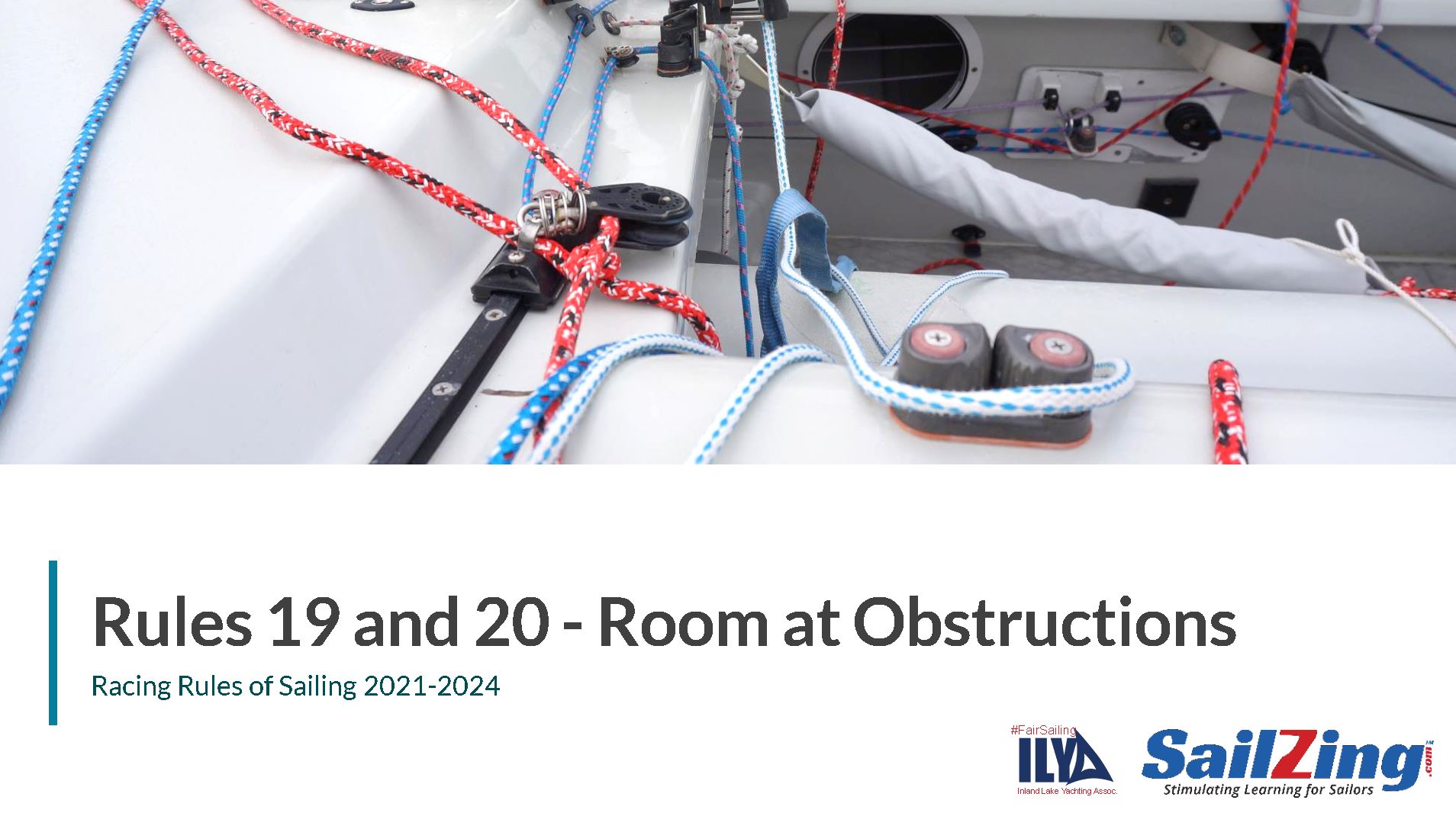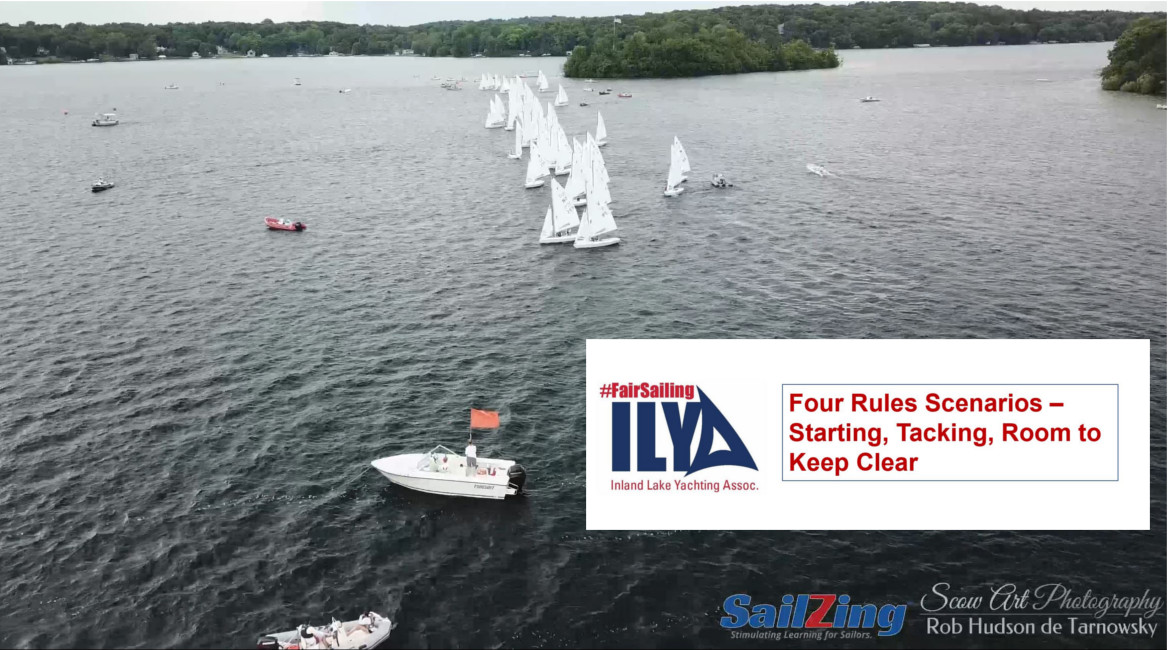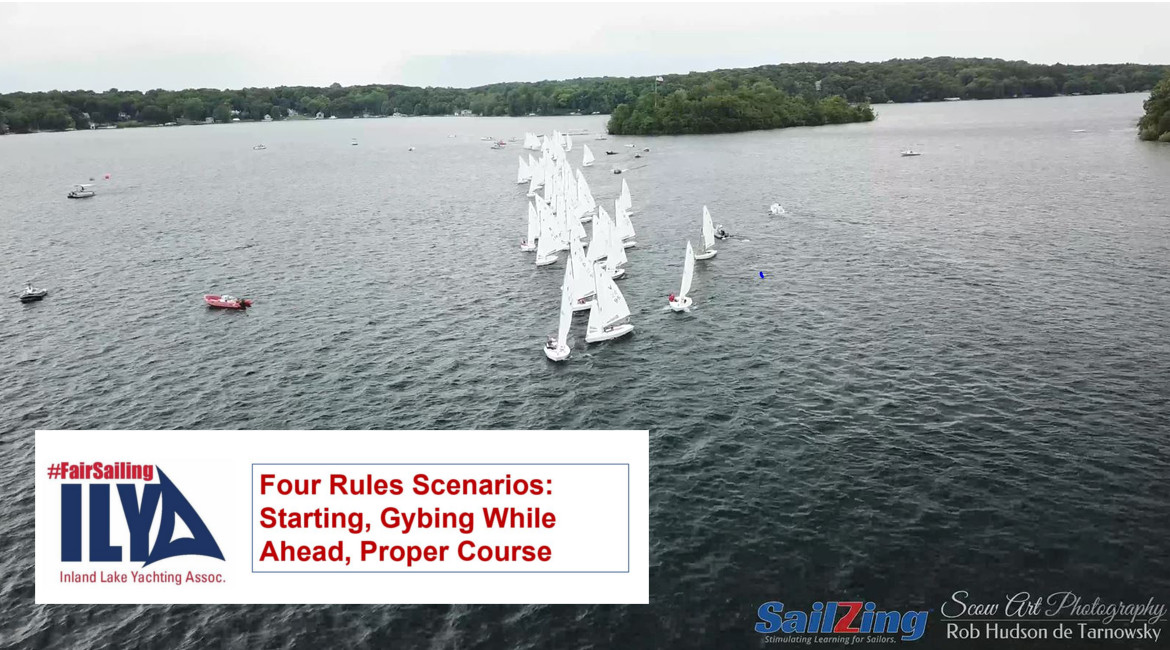In this post, we discuss the rules related to room at obstructions – Rules 19 and 20. Rule 19 addresses room to pass an obstruction. Rule 20 addresses room to tack at an obstruction. Remember that these rules are in Part 2, Section C and therefore do not apply at a starting mark surrounded by navigable water or its anchor line.
In 2018, the Inland Lake Yachting Association (ILYA) and SailZing, LLC partnered on a Fair Sailing initiative. As part of this initiative, SailZing worked with the ILYA and UK Sailmakers to develop a series of articles on the rules. With the rules changes in 2021, SailZing is updating these articles and adding video summaries.
Our thanks to UK Sailmakers for generating the animated scenarios.
Video – Rules 19 and 20
Rule 19 – Room to Pass an Obstruction
19.1 – When Rule 19 Applies

“Rule 19 applies between two boats at an obstruction except
(a) when the obstruction is a mark the boats are required to leave on the same side, or

(b) when rule 18 applies between the boats and the obstruction is another boat overlapped with each of them.
However, at a continuing obstruction, rule 19 always applies and rule 18 does not.”
19.2 – Giving Room at an Obstruction
“(a) A right-of-way boat may choose to pass an obstruction on either side.
(b) When boats are overlapped, the outside boat shall give the inside boat room between her and the obstruction, unless she has been unable to do so from the time the overlap began.
(c) While boats are passing a continuing obstruction, if a boat that was clear astern and required to keep clear becomes overlapped between the other boat and the obstruction and, at the moment the overlap begins, there is not room for her to pass between them,
(1) she is not entitled to room under rule 19.2(b), and
(2) while the boats remain overlapped, she shall keep clear and rules 10 and 11 do not apply.”
Definitions
Obstruction An object that a boat could not pass without changing course substantially, if she were sailing directly towards it and one of her hull lengths from it. An object that can be safely passed on only one side and an object, area or line so designated by the sailing instructions are also obstructions. However, a boat racing is not an obstruction to other boats unless they are required to keep clear of her or, if rule 22 applies, avoid her. A vessel under way, including a boat racing, is never a continuing obstruction.
Previously-defined terms (click to refresh your memory): room, mark, overlap, clear astern, keep clear
Rule 19 Key Points
- Rule 19 does not apply when the obstruction is a mark or in mark-room situations with more than two boats overlapped.
- Under Rule 19, the right-of-way boat gets to choose which side to pass an obstruction.
- The outside boat must give inside overlapped boats room to pass an obstruction. This does not apply at a continuing obstruction if the inside boat becomes overlapped from clear astern with no room to pass.
Rule 19 Changes for 2021
Changes to Rule 19 and the definition of obstruction were minor.
- Rule 19.2(c) was divided into sub-parts (1) and (2) for clarity. The wording did not change.
- The definition of obstruction was expanded to include areas or lines designated by the race committee as obstructions.
Rule 19 Scenarios
#1 – “Starting Line”
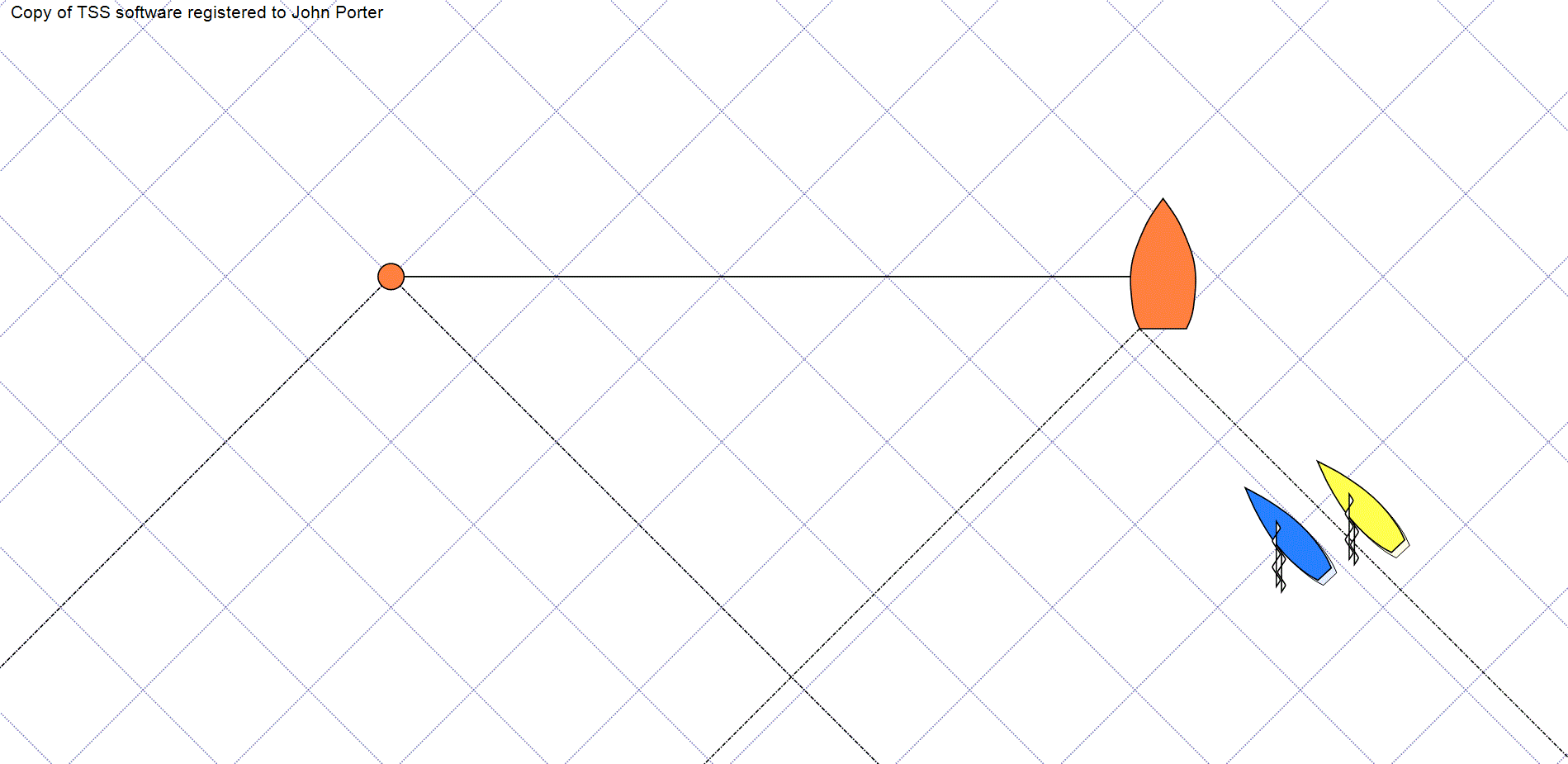
Description: Yellow and Blue are approaching the race committee boat at the starting line, prior to the start.
Is Blue required to give Yellow room to pass inside the RC boat? Answer
#2 – “Starting Line on Shore”
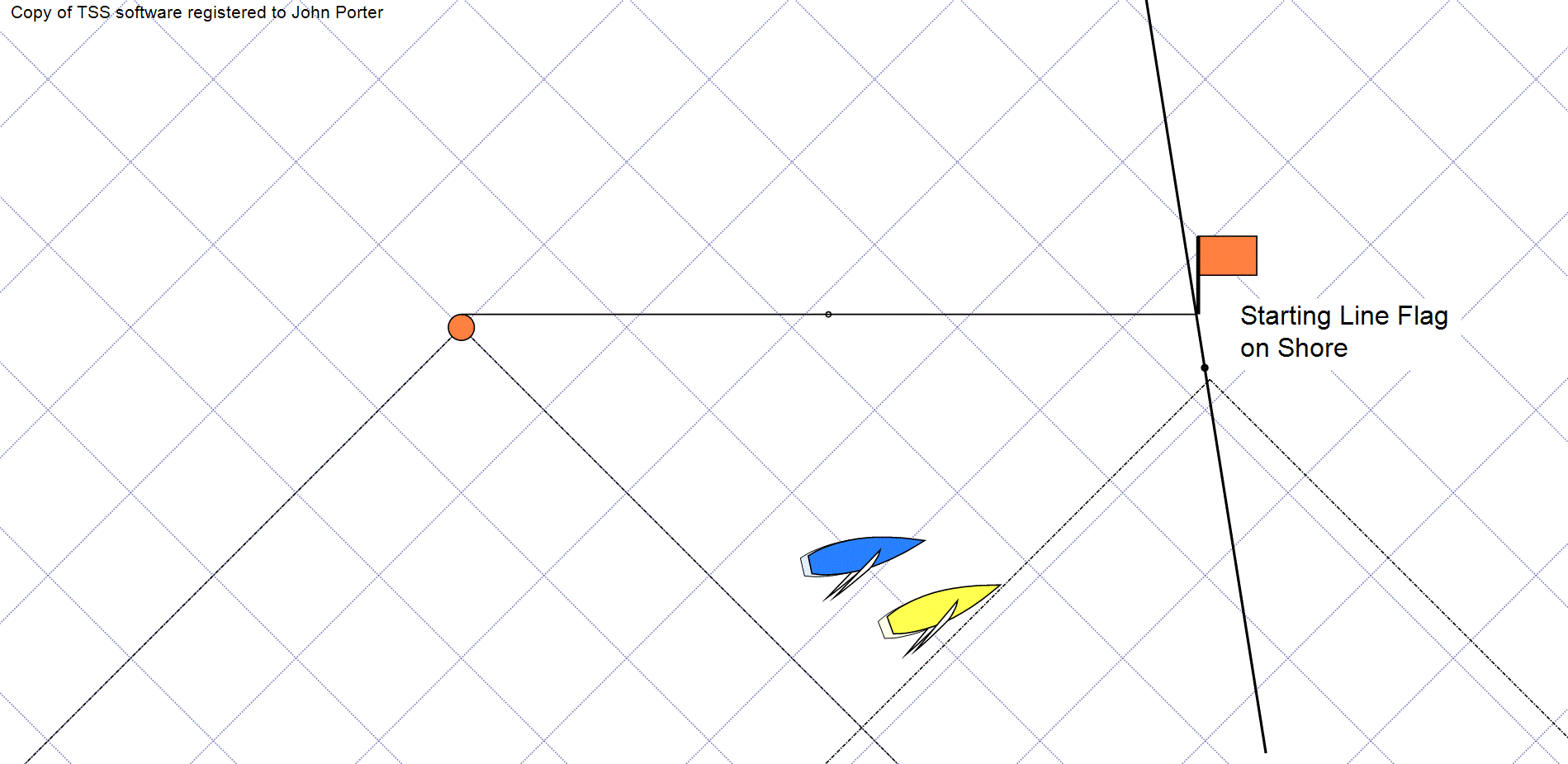
Description: Yellow and Blue are approaching a starting line that has one end on shore.
Does Rule 19 apply in this situation? Answer
#3 – “Over or Under”
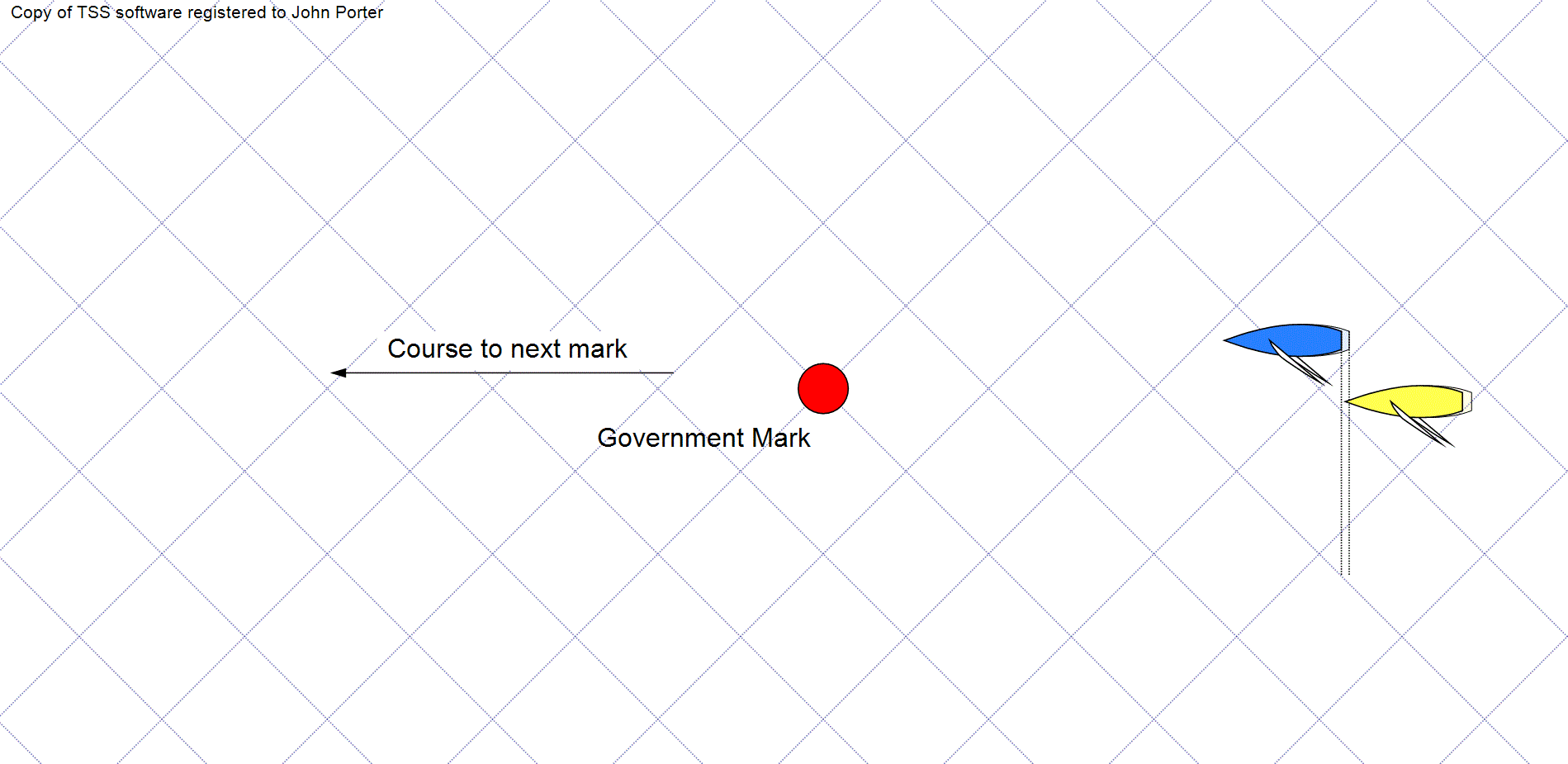
Description: Yellow and Blue are reaching to the next mark, with a government mark in their path. Yellow establishes an overlap from behind and is bound by rule 17 to sail no higher than her proper course. As the boats approach the government mark, Yellow decides to sail to windward of the mark. Blue alleges Yellow broke rule 17 because she could have sailed to leeward of the mark.
Is Yellow required to sail to leeward of the obstruction? Answer
#4 – “Which Room Wins?”
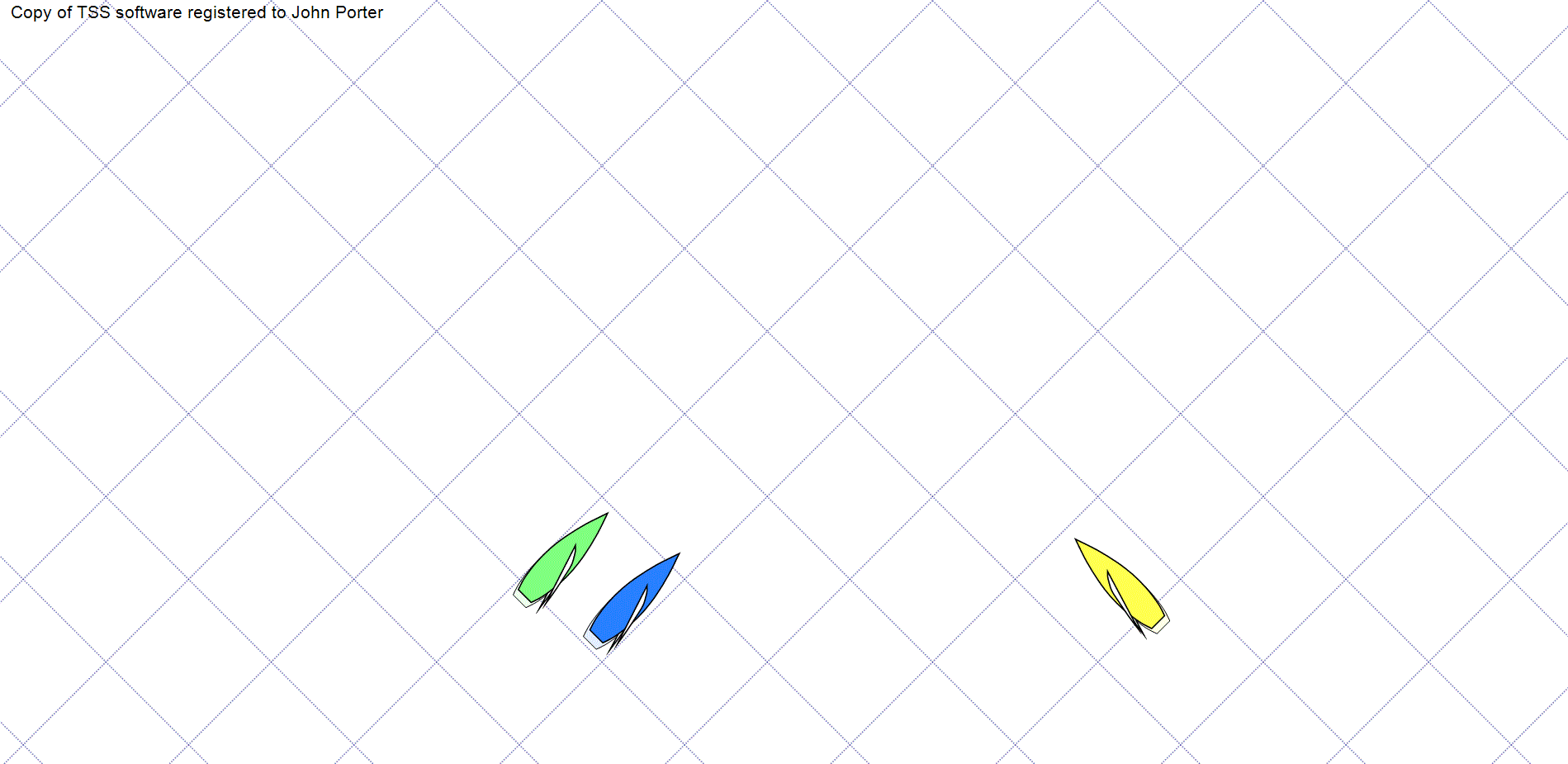
Description: Blue and Green approach Yellow, a starboard boat and an obstruction. Both Yellow and Green hail for room. Green wants to duck Yellow and Blue wants to tack. Blue tacks. Green protests, alleging Blue broke Rule 19.2. There was no contact.
Did Blue break Rule 19.2? Answer
Could Blue duck while forcing Green to tack? Answer
#5 – “Overlap from Astern”
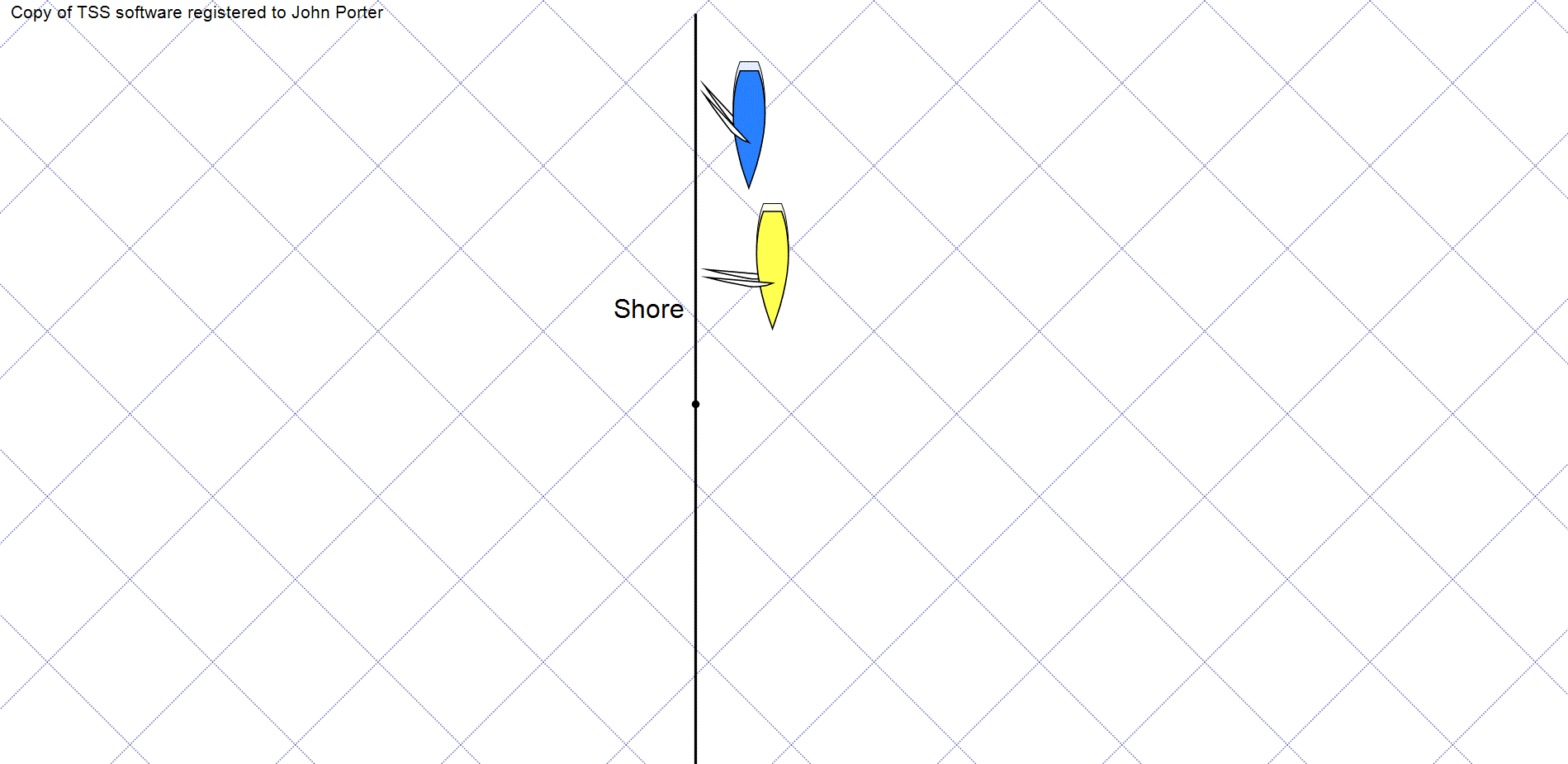
Description: Yellow and Blue are sailing along a shore, which is a continuing obstruction. Blue overlaps Yellow from clear astern. Blue asks Yellow to head up, alleging she is entitled to room.
Is Yellow required to give room to Blue? Answer
Rule 20 – Room to Tack at an Obstruction
20.1 – Hailing
“A boat may hail for room to tack and avoid a boat on the same tack. However, she shall not hail unless
(a) she is approaching an obstruction and will soon need to make a substantial course change to avoid it safely, and
(b) she is sailing close-hauled or above.
In addition, she shall not hail if the obstruction is a mark and a boat that is fetching it would be required to change course as a result of the hail.”
20.2 – Responding
“(a) After a boat hails, she shall give a hailed boat time to respond.
(b) A hailed boat shall respond even if the hail breaks rule 20.1.
(c) A hailed boat shall respond either by tacking as soon as possible, or by immediately replying ‘You tack’ and then giving the hailing boat room to tack and avoid her.
(d) When a hailed boat responds, the hailing boat shall tack as soon as possible.
(e) From the time a boat hails until she has tacked and avoided a hailed boat, rule 18.2 does not apply between them.”
20.3 – Passing On a Hail to an Additional Boat
“When a boat has been hailed for room to tack and she intends to respond by tacking, she may hail another boat on the same tack for room to tack and avoid her. She may hail even if her hail does not meet the conditions of rule 20.1. Rule 20.2 applies between her and a boat she hails.”
20.4 – Additional Requirements for Hails
“(a) When conditions are such that a hail may not be heard, the boat
shall also make a signal that clearly indicates her need for room
to tack or her response.
(b) The notice of race may specify an alternative communication for
a boat to indicate her need for room to tack or her response, and
require boats to use it.”
The 2021 changes added Rule 20.4 in its entirety. The changes enhance safety, in situations when hails made under Rule 20 may not be heard.
Definitions
Previously-defined terms (click to refresh your memory): fetching
Rule 20 Key Points
- Rule 20 is one of only two rules that require hailing. You must hail “room to tack” when approaching an obstruction if you need to avoid a boat on the same tack.
- The hailed boat must respond either by tacking as soon as possible or by hailing “you tack.”
- When a hailed boat responds, the hailing boat must tack as soon as possible.
- The hailed boat may pass on the hail for room to tack to another boat.
Rule 20 Scenarios
#6 – “Approaching Shore, Tack Immediately”
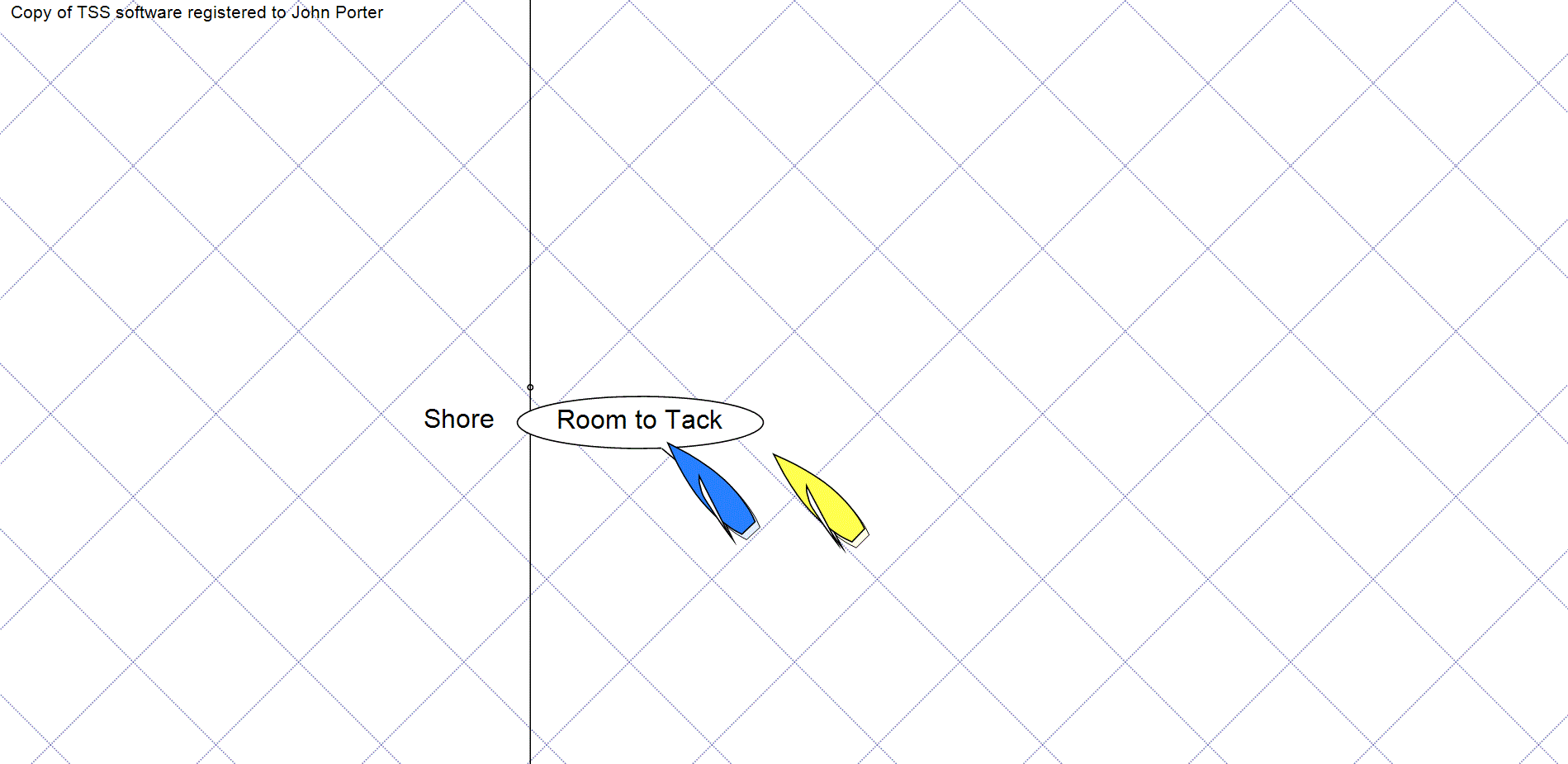
Description: Yellow and Blue are approaching a shore, sailing close-hauled. Blue hails “room to tack.” Yellow tacks immediately and Blue begins her tack as soon as Yellow does.
Should Yellow hail in response to Blue’s hail? Answer
Could Blue have hailed for room to tack if she were reaching? Answer
After Yellow tacked, could Blue have sailed further before tacking? Answer
#7 – “Approaching Shore, You Tack”
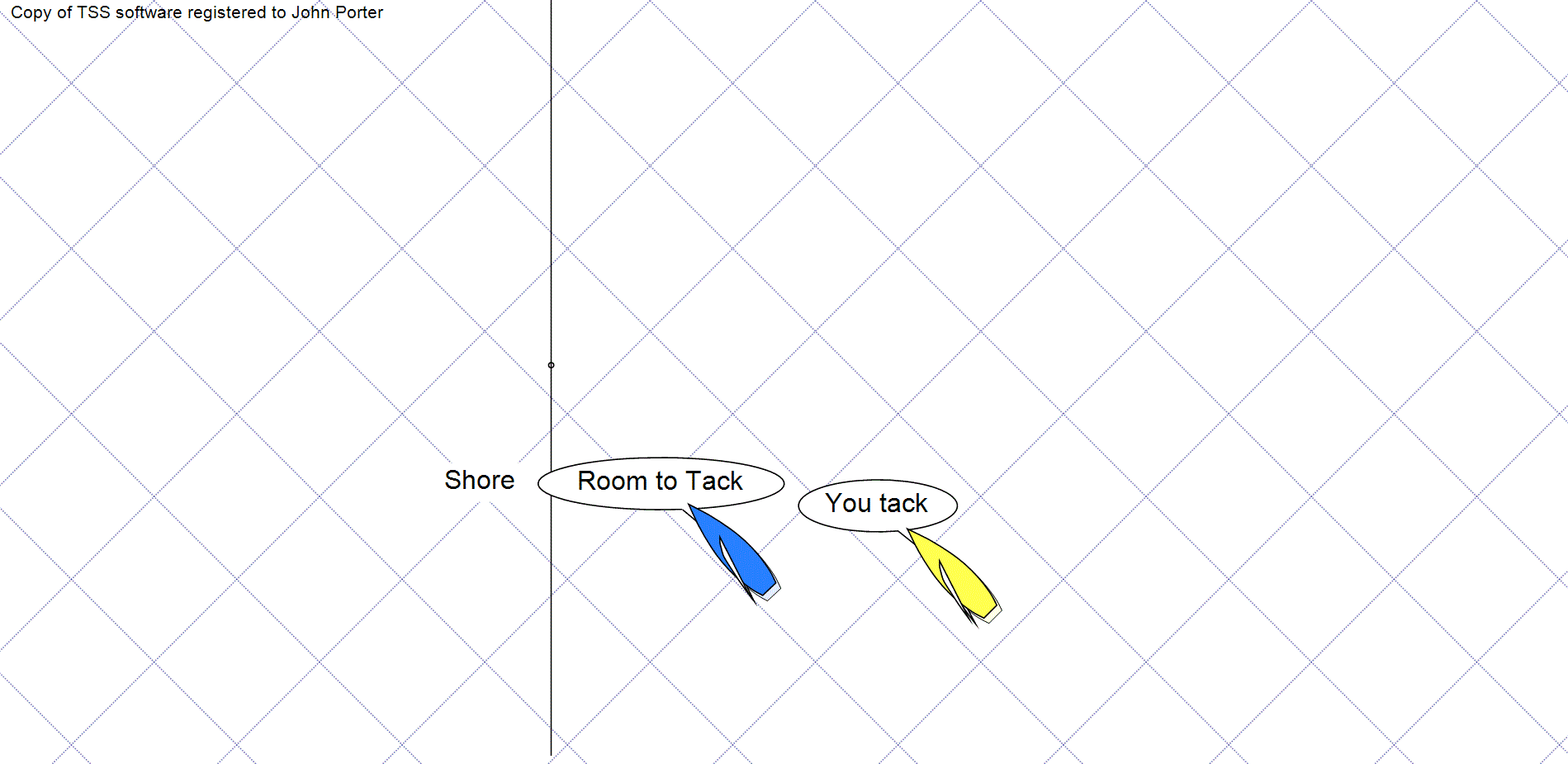
Description: Yellow and Blue are approaching a shore, sailing close-hauled. Blue hails “room to tack.” Yellow hails “You tack,” and ducks Blue.
Could Yellow also tack immediately after responding? Answer
#8 – “Passing on the Hail”
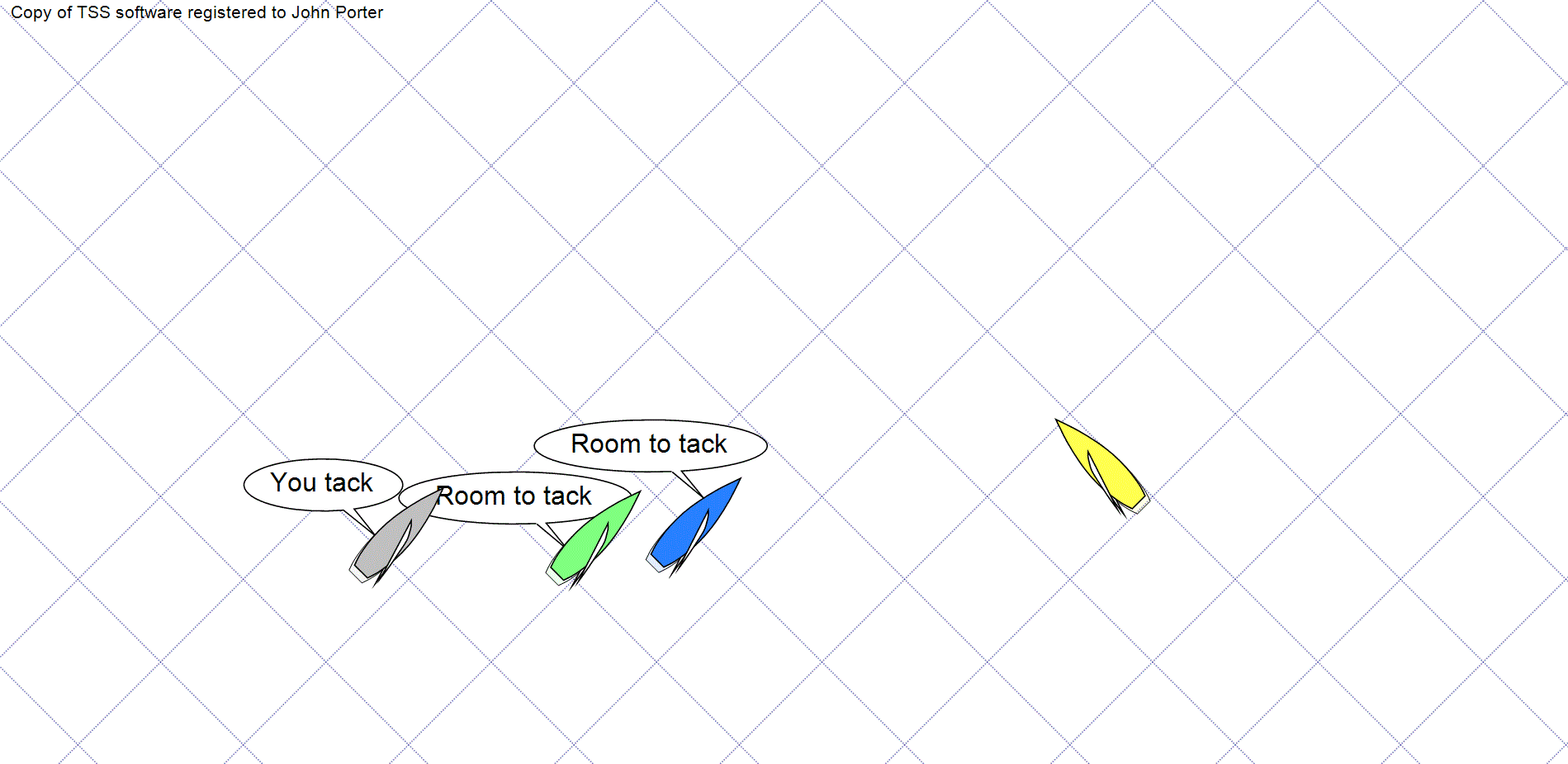
Description: Blue, Green, and Grey are approaching Yellow, an obstruction. Blue hails “room to tack.” Green passes on the hail to Grey by saying “room to tack.” Grey responds “you tack.” Blue and Green tack, and Grey ducks.
Could Green have decided to hail “you tack” in response to Blue’s hail? Answer
Should Grey respond to Green’s hail? Answer
World Sailing Cases of Interest
3 – A leeward port-tack boat hailing for room to tack, is not required to anticipate that the windward boat will fail to comply with her obligation to tack promptly or otherwise provide room.
10 – If a boat hails for room to tack when she is neither approaching an obstruction nor sailing close-hauled or above, she breaks rule 20.1. The hailed boat must respond even if the hail breaks rule 20.1.
11 – When boats are overlapped at an obstruction, including an obstruction that is a right-of-way boat, the outside boat must give the inside boat room to pass between her and the obstruction.
29 – A leeward boat is an obstruction to an overlapped windward boat.
54 – Timing of hail and response.
101 – Right-of-way does not transfer to the boat entitled to room.
113 – Interaction between three boats at an obstruction.
117 – Overlapped boats overtaking a third boat
Related Content:
SailZing – Racing Rules Category
Racing Rules 2021-2024
When does Rule 20.2(e) Apply – Sailing World Article
Sailors Helping Sailors
Will you share your knowledge with your related Comments below?

